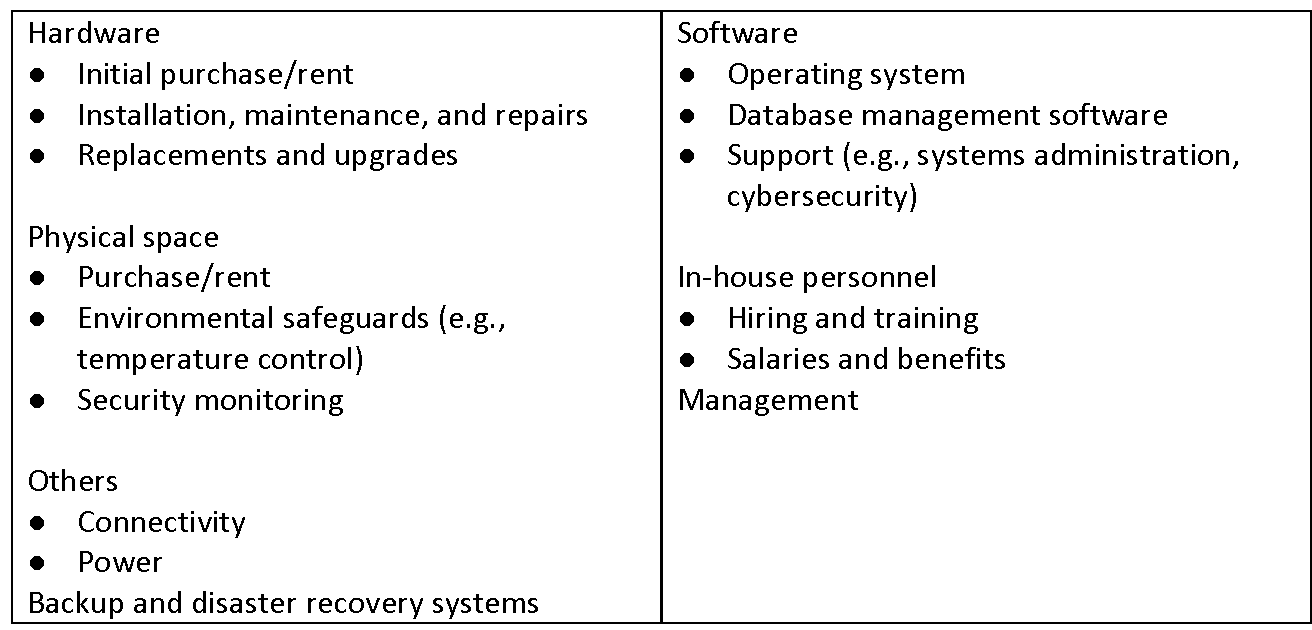On-site or cloud hosting? Which is the better choice for your business?

Sophisticated businesses in America today use in-house and/or third-party apps to facilitate operations — and these apps run on databases. For example, marketing and sales departments use customer databases, while purchasing and procurement departments use supply chain and inventory databases.
For the sake of optimizing your operations, where must your business host your data? Considering cost, control, and configuration requirements, should it be hosted in-house or in the cloud? Let’s take a quick look at your options to help you decide.
On-site hosting
To host your data on premises is to build and maintain an IT infrastructure in the physical spaces your business uses. While users are on premises, they can access apps and data via the company’s intranet, a computer network that’s exclusively for members of an organization. Remote workers may be permitted to access the internal network via an internet connection.
Assuming you have no hosting solution implemented yet, these will most likely be your considerations:
Costs
Among all the hosting types, on-premises hosting will incur the greatest cost since it entails acquiring the resources to install, operate, and maintain it yourself.
Control
With on-site hosting, most if not all of the hosting resources are under your purview, so this grants you the greatest control over your data and systems as compared to other hosting options.
Configuration
In-house hosting is immensely complex, which is why you’ll need people with highly technical skills. It’s also why it takes the longest among the hosting options to bring online. However, with that said, on-site hosting is the easiest to align with how your internal apps work and interact with one another.
Additionally, complexity plus prohibitive costs make this type of hosting very difficult to scale up and also cost-inefficient when your business needs to scale down.
Cloud hosting
Here, the task of hosting is outsourced to a cloud services provider (CSP). Instead of being located in on-site servers, your apps and databases are in the cloud, and users may access these wherever they have an internet connection.
There are two types to choose from, namely Infrastructure-as-a-Service (IaaS) and Database-as-a-Service (DBaaS).
Cost
The CSP takes on most of the costs associated with hosting. Essentially, the provider rents out its IT infrastructure to clients and charges for defined levels of service (that is, service level agreements or SLAs) for systems administration, performance monitoring, and cybersecurity protection, among others.*
With IaaS, you’ll still need to purchase or rent your own operating system and database software licenses — or bring your own licenses (BYOL), if you already have them. This grants you the power of choice. With DBaaS, on the other hand, a CSP will have their own OS and DB licenses already included in the hosting package.

Do note that if you already have an on-site infrastructure and you’re planning to migrate to the cloud, migration costs may make the cloud more expensive than your initial setup during the first few months of your transition. Additionally, your “rent” will depend on the amount of resources you decide must be allotted to you, and that the “service charge” is tantamount to the services you’ll utilize. This means that you’ll need to control how much you spend on cloud services.
Control
Among the hosting options, DBaaS will grant you the least amount of control over your data because the CSP owns all of the hosting resources. A DBaaS vendor may provide you with tools to administer and monitor your DBaaS setup yourself, but the provider takes care of everything at the backend.
As a client, you can exercise greater control with IaaS, since many software components will still be in your hands.
Configuration
The CSP takes care of most if not all of your hosting configuration requirements. In terms of level of effort from the client’s end, DBaaS is the easiest to scale up or down and the least complex to set up. However, since the operating system and database software are all handled by the vendor, there may be difficulty in aligning these with your internal apps. Using third-party tools may also be problematic since the changes that the vendor applies to their systems may result in misconfigurations.
IaaS may be harder to set up, but it does allow you to configure your hosting solution to your liking. The software will match your internal apps better, and you can use your favorite third-party software more freely, too.
At the end of the day, your choice of hosting solution depends on what you currently have and what you want to achieve in the foreseeable future. If you’re thinking about migrating to the cloud, talk to our experts at SimplyCouds. We’ll help you choose the right solutions and guide you in optimizing your cloud spend so that you can take your business to the next level.
Businesses rely on SimplyClouds for top-notch cloud services and security. To learn more about how your business can leverage the cloud, contact us today.
Categories: Cloud services, Cloud providers, Cloud migration
Tags: cloud migration, cloud providers, cloud operational costs, cloud expenses, CSP, IaaS, DBaaS
Share